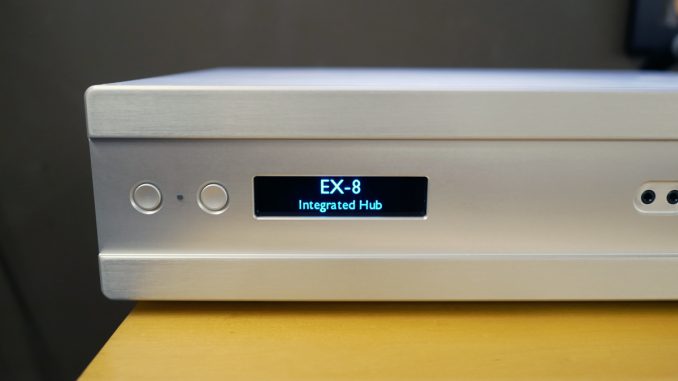
Last year, I reviewed and compared six streaming integrated amplifiers as Editor of AudioStream. I find value in these types of comparisons both as a doer and as a reader because comparative listening to like-components allows us to readily hear the sonic flavors baked into each one. From there, we can decide which matches our preferred sonic pallet and coupled with other factors including feature set, power, and eye appeal, zero in on the One. At least that was the plan before the Ayre EX-8 Integrated Hub showed up in the barn.
I can think of no better component to kick-off the reviews here at TM than the EX-8 for a number of reasons—it is a continuation of my interest in and exploration of streaming integrated amplifiers (the Ayre’s streaming capabilities are optional which is one aspect of its modular design), I have real experience with Ayre’s products, having owned and loved their AX-5 Twenty Integrated amp, and while I had my preferences among the six I reviewed last year (Cary AiOS, SimAudio Nēo Ace, Technics SU-G30, Hegel Röst, Peachtree nova300, Lumin M1), none of them really lit my fire. Oh, and I love streaming integrated amplifiers.
What is a streaming integrated amplifier? Good question. Let’s start with the easy part—an integrated amplifier combines a preamplifier and power amplifier in one box. The preamp takes in signals from analog sources like CD players and cassette decks and essentially provides voltage gain, making these weaker signals stronger, among other things like volume control. The power amplifier in turn takes the line level output from the preamp and amplifies it further so the output can drive your speakers. I know you probably know this but it never hurts to not assume everyone does.
The “streaming” part of this one-box picture adds a number of additional functions. These include an Ethernet input which accepts digital data from your network. This means you can play streaming services directly into your streaming integrated amplifier (which ones depends on the device). Another function that comes along with “streaming” is a digital-to-analog converter (DAC), which converts the digital, or binary, data into an an analog signal. Some streaming integrated amplifiers, like the Ayre, also offer additional digital inputs such as S/PDIF and USB. The network input can also be Roon-Ready, meaning you can use Roon to control digital playback. I hate to sound like a broken record, but being Roon-Ready is not so much a feature in terms of my enjoyment as it is a function of it. The EX-8 with network board is Roon-Ready and pre-configured to stream Spotify, Qobuz, and Tidal. To clarify the EX-8 options, the base unit is analog only, to which you can add S/PDIF inputs, a USB input, and the network board. The review sample came fully loaded.
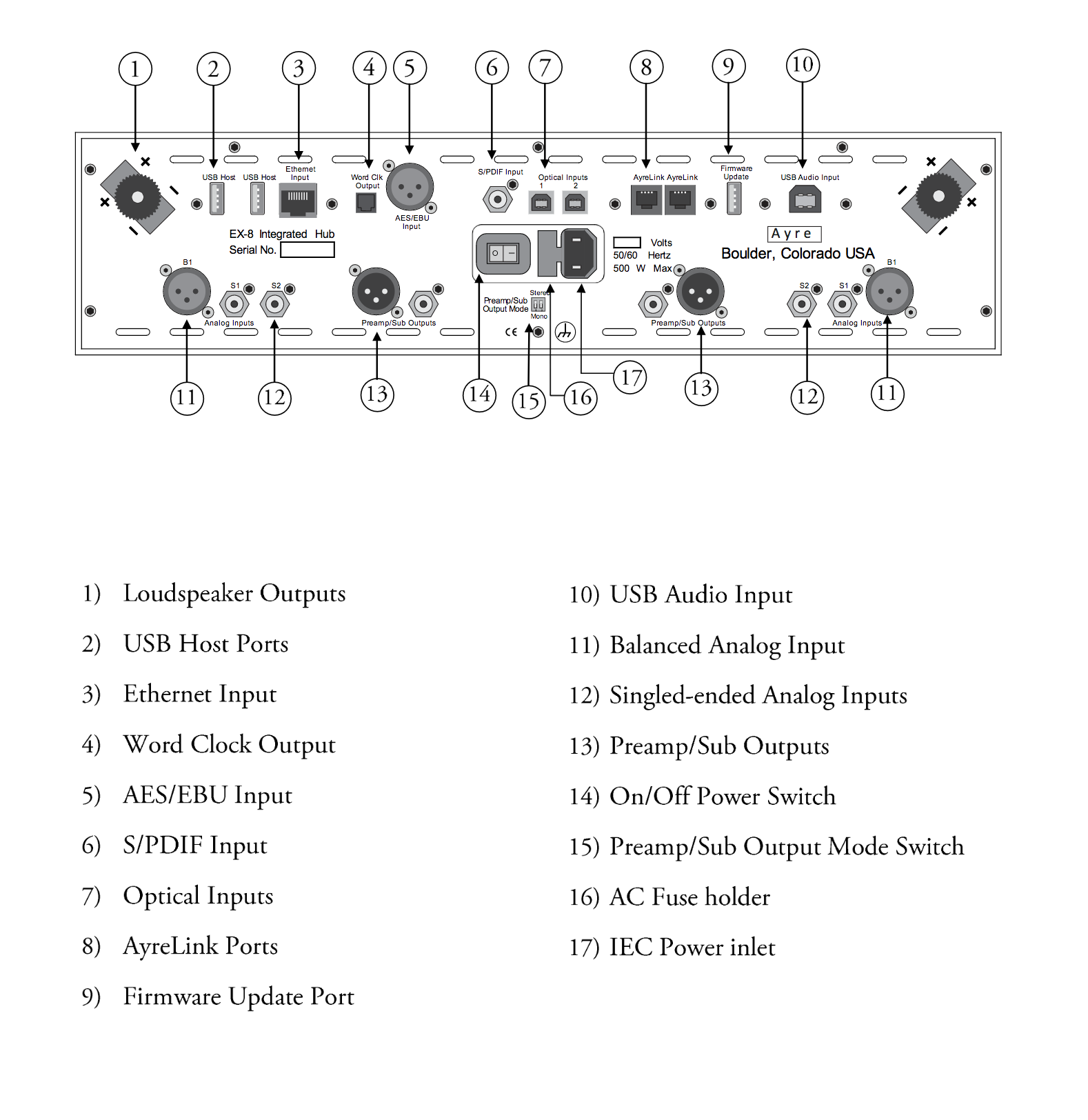
The Ayre EX-8 Integrated Hub with the optional network board, which is how I reviewed it and how I recommend buying it, is a 100 watt per channel (into 8 ohms) streaming integrated amplifier so it offers analog and digital inputs. Thanks to the EX-8 manual, you can see every one of ’em in the image above so I don’t have to re-type what someone at Ayre already typed.

On the digital side, the USB input goes the highest, offering PCM playback up to 384kHz and DSD128. The network connection tops out at 192kHz and DSD64. I don’t know about you, but my music collection is mainly regular-old 16/44 with some 24/48 and 24/96 sprinkled in. I can count on the fact that I’ll very rarely play a 24/88, 24/192 or DSD128 file, and I can count on one fingerless hand the number of times I’ll play a 384kHz file. All to say I can and did live with the Ayre’s network connection for the entire time. If you think about it, adding another device like a computer or network player so you can use the EX-8’s optional USB input means you’ve added another box to your one-box system in order to play certain files. If you use Roon, you can just tell it to convert those files into rates the EX-8’s network input understands and call it a day. That’s what I’d do.
There are a number of Ayre’s home grown features inside the EX-8, carried over and trickled down from other Ayre products. These include Ayre’s fully-balanced, zero-feedback circuitry, custom digital clock, Minimum Phase digital filter, Single-pass 16x oversampling, Ayre’s Double Diamond output stage, and Ayre’s exclusive Equilock gain stage. The most important thing to know about these features is they are designed to make you enjoy listening to your music through the EX-8. Let’s see if they work as advertised.
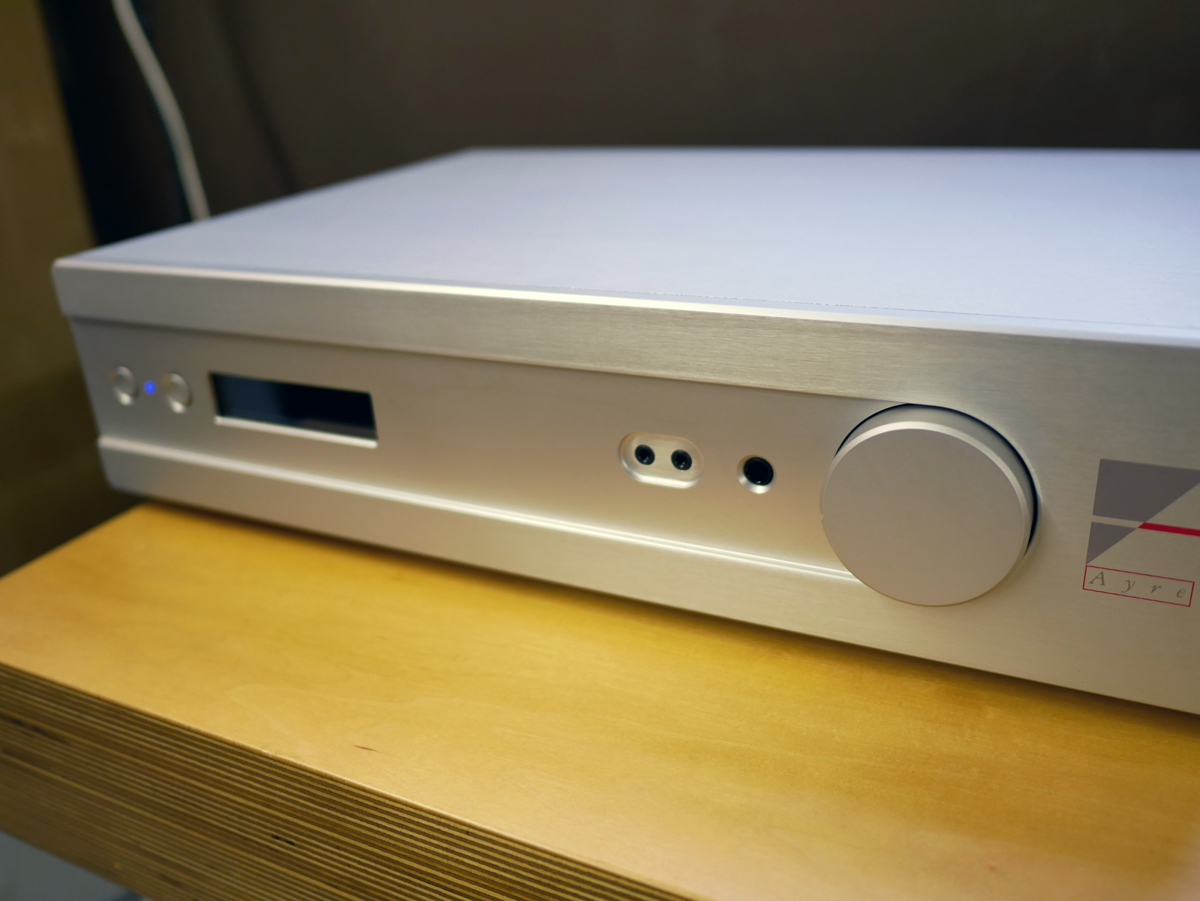
As you can see from the photos, the EX-8 is fairly spartan in appearance, wrapped in anodized aluminum with a slight indent where control buttons, display, and balanced and single-ended headphone outputs sit. The right side of the indent ends with an equally sized volume knob for the analog volume control. If I could change anything about the Ayre, I’d ask for little more sexiness in its appearance which I have no idea how to pull off. One thing to note is the EX-8 runs on the hot side so you’ll want to give it space to breath.
The EX-8 drove my DeVore Fidelity gibbon X and the Well-Tempered Amadeus/Denon 103/Auditorium 23 Step Up/Sugden A21 Stage Two phono amp took care of spinning my vinyl (review system details). Getting the EX-8 ready to play in the barn took all of a few minutes. Unbox, place on rack, connect speaker cables, connect Ethernet cable, connect power cable, turn it on. Set Roon to play through the EX-8 and play music. The Roon app also allows you to control the EX-8’s volume so if you’re digital only, there’s nearly no need for the included remote.
When I went to Herb Reichert’s opening at the John Davis Gallery, Herb was very excited to show me the lighting in the lower level galleries. Apparently, John Davis uses NOS lights that were specifically designed to light up art and Herb was excited for me to see them because they brought out aspects of his paintings that other lighting failed to illuminate. And Herb meant this quit literally—viewing his paintings lit by these lights allowed the viewer to see things in his paintings, like depth, subtle variations in tone and texture, that other lights obscured. As if they weren’t there.
You can understand why Herb was so excited—people could better see his works and therefore better understand his intent. Think of it like reading a book in the light versus reading in the rain. At night.

As I listened to the Ayre EX-8 over days and weeks, I kept thinking about Herb’s lights. The reason being, the EX-8 illuminated my music in very much the same manner. Every aspect of a recording is there for the listening, sorted out with life-like detail and resolution, spatially as roomy as the recording allows, and as powerful and pounding and infectious as what you choose to spin. You could say the Ayre EX-8 shines a bright cool light onto the musical signal, allowing the listener to hear as deeply into the recording as time and attention allows.
In my experience, this not common. It is especially uncommon in a one-box, streaming integrated amplifiers where some of the pieces and functions inside the box can sound as if they’ve compromised their performance in order to fit in with all of the other pieces. Not so the EX-8.

As is my wont, I listened to all manner of digital music from my NAS-based collection and streaming from Tidal. I never, ever look for what to play next based on file resolution. My interests just don’t allow it. Lately I’ve been liking things on the harder/darker side so Cecilia’s Adoration and Charity Whore saw playing time as did DJ Logic, Marie Davidson, Ipek Gorgun, Schammasch, KEN mode, Ill We Are Ill, Emptyset, and Last Exit. Lots of Last Exit. I also played some old favorites, songs and albums, some of which I’ve been listening to for 40 or so years (ouch). Hendrix, Tom Waits, Nick Cave, PJ Harvey, Satie, Debussy, Sinatra, Springsteen, and on and on. And on.

You know when your hifi is doing its job when you find yourself rolling along with music leading the way for hours on end, day after day. I wish this was always the case with everything I review, but it’s not. Sometimes some piece of kit calls undue attention to itself by messing with the music. With digital, this often means edges can become unnaturally hard, string instruments can get brittle, and the sound image can flatten out to the point where it feels like the music is hitting a wall of glass. All told, ick.
Some amplifiers can make things sound mushy, dark, and generally snooze-worthy. Here, the “skipping to the next song before the song that’s playing is over” syndrome is a sure sign of said ickiness. Music is life’s blood and if it doesn’t move you, if it doesn’t toss your emotions around like a cork in a storm, if it doesn’t make you jump up and dance like a fool ( I’m speaking for myself), something is not working as it should.

With the Ayre EX-8 in control, and its 100wpc drove the DeVore’s with ease, I felt that spark of life in every recording I played. This is because the EX-8 illuminates music’s intent. It also offers a very well balanced musical presentation and one that’s devoid of digital’s typical tell-tale failings. I also moved the Ayre from center stage, the land of the one-box streaming amplifier, to my rack so that I could also listen to records. Yer basic LPs. Analog. I started off with a lovely red 10″, George Antheil’s Fourth Piano Sonata played by Frederick Marvin (Alco Recording Company ALP 1007), something I picked up in Hudson, NY after Herb’s opening. I didn’t know whether to march or hop around like a bunny but there’s a lot of life and lift in this Antheil sonata and the EX-8 kept right up. Perhaps better than I did.
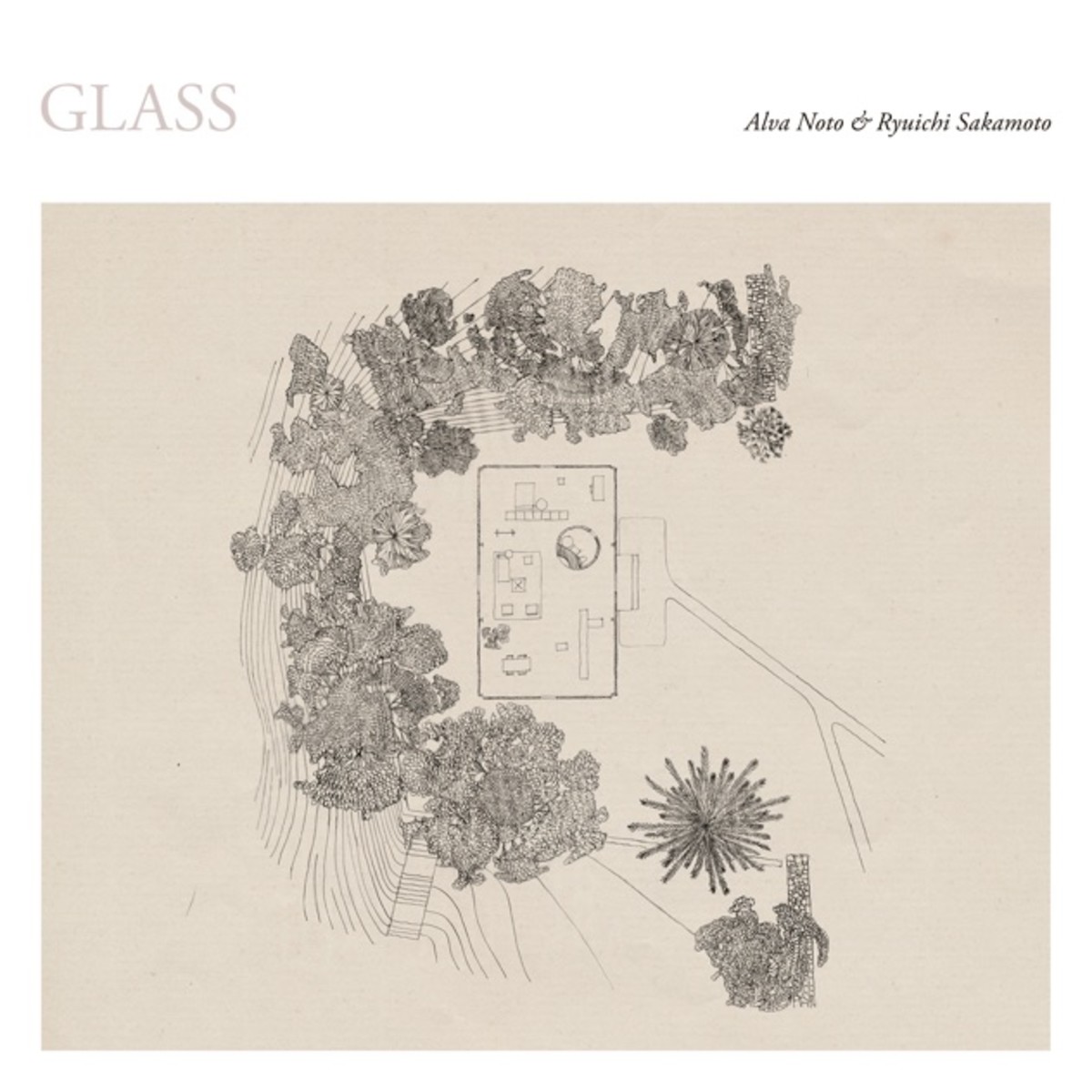
I moved on to some other recent and recent-ish LP purchases including Pan Daijing’s Lack, Grouper’s Grid of Points, the perfect concept / perfectly lovely Glass from Alva Noto and Ryuichi Sakamoto, Ora Io’s Image Certifies, and more. Of course here I’m talking about my phono setup as much as the Ayre’s analog input but as I expected, the Ayre’s sonic characteristics noted through the network input carried over to analog. My music was presented as freshly and cleanly as if all of the mechanics, electronics, cables, and other things acted as ushers, escorting the music through to the DeVore’s unencumbered.

This same sense of musical-quality clarity came through through the single-ended headphone output using my AudioQuest NightOwls as ear goggles (see Jimi Hendrix Loose Ends). I do not spend much time listening to ‘phones in the barn because there’s no need to. I’m usually the only one in here and there are no neighbors near enough for me to annoy regardless of how much the barn shakes and rattles. I have yet to make it roll. If you look at reviews of the Ayre Codex, you’ll see Ayre knows how to design a headphone amp and the EX-8 drove the NightOwls to my smiling satisfaction. Blixa sounded as if he was singing from inside my head which is always kinda cool and frightening at the same time.
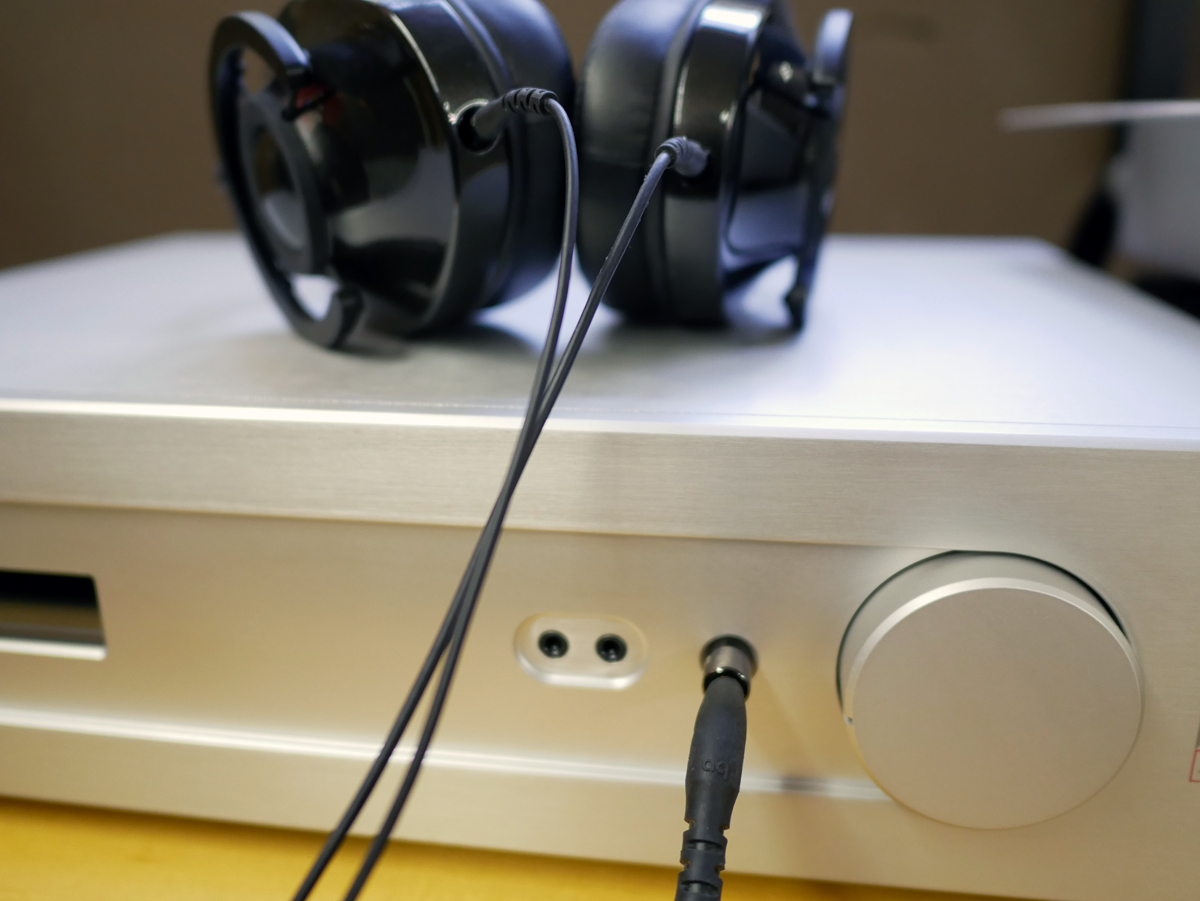
Comparisons. As I hinted at up front, the Ayre EX-8 is by far the most engaging and musically satisfying streaming integrated amplifier I’ve heard by a wide margin. It is also the most expensive. The SimAudio Nēo Ace ($3500) was my sound quality pick out of The Six I reviewed for AudioStream. The Ayre is in another league.
Going back to my system of separates, Leben CS600 integrated amp ($6500), dCS Network Bridge ($4250), and totaldac d1-seven (17450euros) brought more of music’s micro and macro to life. Through my system, music is fuller, richer, and even more uncannily present as compared to the EX-8. The thing about comparisons like this is they are rather silly for a few reasons. No one, in their right mind, would consider spending $7,850 or $30k+ for the same thing, let alone expect that $7,850 will get you more than $30k. That said, if you read hifi reviews, you may read about “giant killers” but my thought about such claims have always been—they must have picked the wrong giant.
To be clear, I’m not suggesting that more money always buys more happiness, but in the case of Ayre vs. The Six, it does. One area where the Ayre differed from my system in a pleasant way was its control of the lower end of the musical spectrum. The Ayre maintained tight-fisted, full-bodied control no matter how low I wanted to go. By comparison, my system’s grip is not as firm.
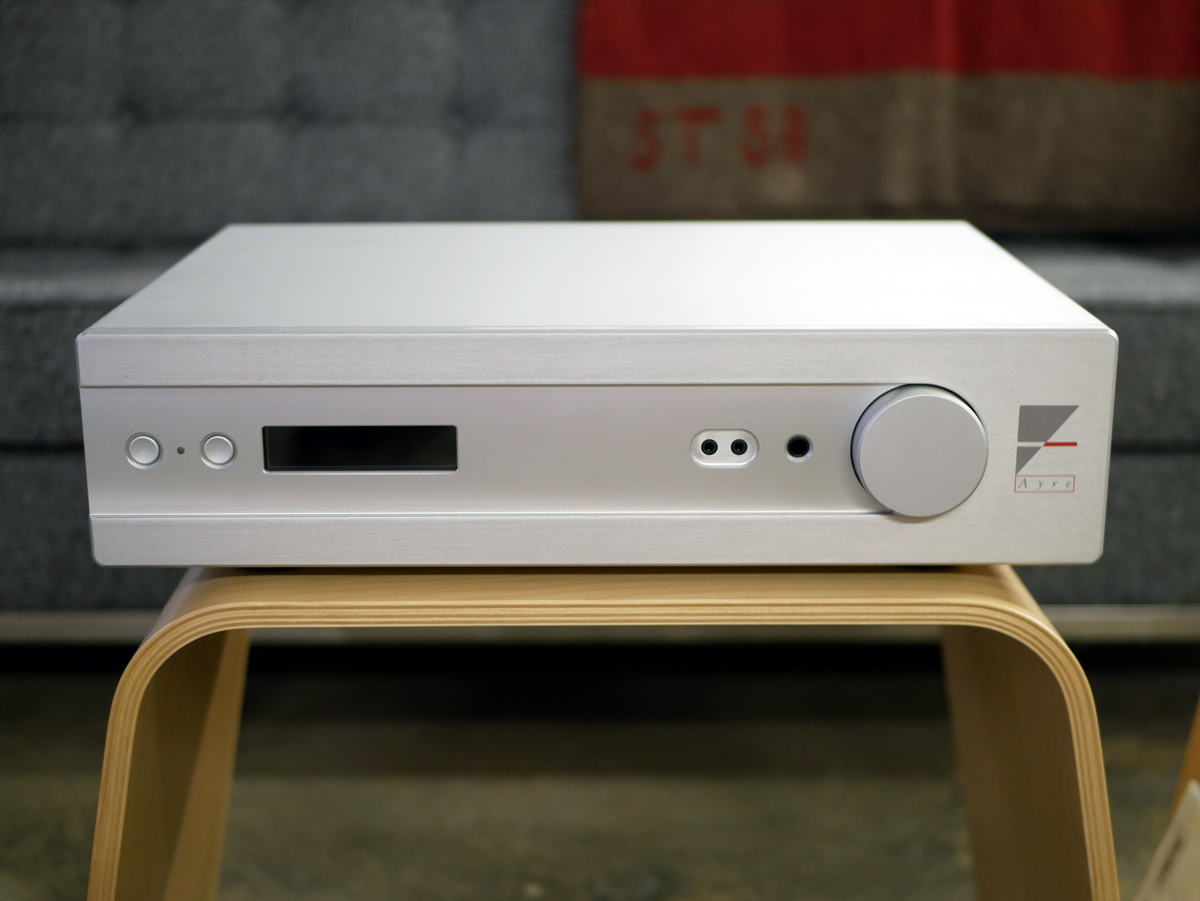
While the Ayre EX-8 does not sound the same as my much more costly separates, it does make wonderful sounding music. I cannot think of one reason why owning one would lead to anything other than complete enjoyment. This puts the Ayre in rarefied air in my experience and if you’ve been looking for and listening to giants and they’ve come up short, you may find that the EX-8 stands as tall as you need.
The Ayre EX-8 leaps onto the TM Select list of components whose performance is well above the herd.
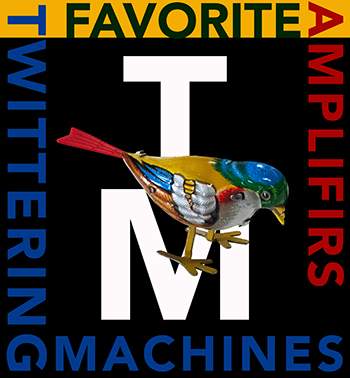
Price:
$5,990.00 (analog-only)
$6,950 + Digital Base (S/PDIF)
$7,450 + Digital Base + USB
$7,650 + Digital Base + Network/Ethernet
$7,850 all of the above
$7,850.00 as reviewed
Specifications
Company Info
Ayre Acoustics
6268 Monarch Park Place, Suite B
Niwot, Colorado 80503 USA
Phone Number : + 1 303.442.7300
Email: [email protected]

